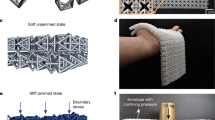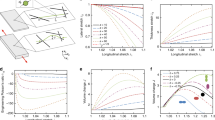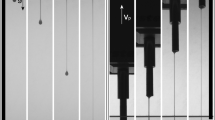Abstract
Designing structures that dilate rapidly in both tension and compression would benefit devices such as smart filters, actuators or fasteners. This property however requires an unusual Poisson ratio, or Poisson function at finite strains, which has to vary with applied strain and exceed the familiar bounds: less than 0 in tension and above 1/2 in compression. Here, by combining mechanical tests and discrete element simulations, we show that a simple three-dimensional architected material, made of a self-entangled single long coiled wire, behaves in between discrete and continuum media, with a large and reversible dilatancy in both tension and compression. This unusual behaviour arises from an interplay between the elongation of the coiled wire and rearrangements due to steric effects, which, unlike in traditional discrete media, are hysteretically reversible when the architecture is made of an elastic fibre.
This is a preview of subscription content, access via your institution
Access options
Subscribe to this journal
Receive 12 print issues and online access
$259.00 per year
only $21.58 per issue
Buy this article
- Purchase on Springer Link
- Instant access to full article PDF
Prices may be subject to local taxes which are calculated during checkout




Similar content being viewed by others
References
Bao, G. & Suresh, S. Cell and molecular mechanics of biological materials. Nature Mater. 2, 715–725 (2003).
Poquillon, D., Viguier, B. & Andrieu, E. Experimental data about mechanical behaviour during compression tests for various matted fibres. J. Mater. Sci. 40, 5963–5970 (2005).
Masse, J. P., Salvo, L., Rodney, D., Bréchet, Y. & Bouaziz, O. Influence of relative density on the architecture and mechanical behaviour of a steel metallic wool. Scr. Mater. 54, 1379–1383 (2006).
Hall, L. J. et al. Sign change of Poisson’s ratio for carbon nanotube sheets. Science 320, 504–507 (2008).
Laurent, C. et al. Mechanical behaviour of a fibrous scaffold for ligament tissue engineering: Finite elements analysis vs. X-ray tomography imaging. J. Mech. Behav. Biol. Mater. 40, 222–233 (2014).
Ashby, M. Designing architectured materials. Scr. Mater. 68, 4–7 (2013).
Zheng, X. et al. Ultralight, ultrastiff mechanical metamaterials. Science 344, 1373–1377 (2014).
Barbier, C., Dendievel, R. & Rodney, D. Role of friction in the mechanics of nonbonded fibrous materials. Phys. Rev. E 80, 016115 (2009).
Picu, R. C. Mechanics of random fiber networks—A review. Soft Matter 7, 6768–6785 (2011).
Smith, C. W., Wootton, R. J. & Evans, K. E. Interpretation of experimental data for Poisson’s ratio of highly nonlinear materials. Exp. Mech. 39, 356–362 (1999).
Greaves, G. N., Greer, A. L., Lakes, R. S. & Rouxel, T. Poisson’s ratio and modern materials. Nature Mater. 10, 823–837 (2011).
Nicolaou, Z. G. & Motter, A. E. Mechanical metamaterials with negative compressibility transitions. Nature Mater. 11, 608–613 (2012).
Lakes, R. Foam structures with a negative Poisson’s ratio. Science 235, 1038–1040 (1987).
Evans, K. E., Nkansah, M. A., Hutchinson, I. J. & Rogers, S. C. Molecular network design. Nature 353, 124 (1991).
Delannay, F. Elastic model of an entangled network of interconnected fibres accounting for negative Poisson ratio behaviour and random triangulation. Int. J. Solids Struct. 42, 2265–2285 (2005).
Tatlier, M. & Berhan, L. Modelling the negative Poisson’s ratio of compressed fused fibre networks. Phys. Status Solidi B 246, 2018–2024 (2009).
Neelakantan, S., Bosbach, W., Woodhouse, J. & Markaki, A. E. Characterization and deformation response of orthotropic fibre networks with auxetic out-of-plane behaviour. Acta Mater. 66, 326–339 (2014).
He, G., Tan, Q., Jiang, G. & Li, Q. A novel mechanism for auxetic behavior in entangled materials with a spiral wire structure. Smart Mater. Struct. 23, 095011 (2014).
Baughman, R. H., Stafström, S., Cui, C. & Dantas, S. O. Materials with negative compressibilities in one or more dimensions. Science 279, 1522–1524 (1998).
Baughman, R. H. Auxetic materials: Avoiding the shrink. Nature 425, 667 (2003).
Goodwin, A. L., Keen, D. A. & Tucker, M. G. Large negative linear compressibility of Ag3[Co(CN)6]. Proc. Natl Acad. Sci. USA 105, 18708–18713 (2008).
Fortes, A. D., Suard, E. & Knight, K. S. Negative linear compressibility and massive anisotropic thermal expansion in methanol monohydrate. Science 331, 742–746 (2011).
Brown, A. E., Litvinov, R. I., Discher, D. E., Purohit, P. K. & Weisel, J. W. Multiscale mechanics of fibrin polymer: Gel stretching with protein unfolding and loss of water. Science 325, 741–744 (2009).
Zhang, M., Atkinson, K. R. & Baughman, R. H. Multifunctional carbon nanotube yarns by downsizing an ancient technology. Science 306, 1358–1361 (2004).
Aliev, A. E. et al. Giant-stroke, superelastic carbon nanotube aerogel muscles. Science 323, 1575–1578 (2009).
Reynolds, O. Dilatancy. Nature 33, 429–430 (1886).
Onoda, G. Y. & Liniger, E. G. Random loose packings of uniform spheres and the dilatancy onset. Phys. Rev. Lett. 64, 2727–2730 (1990).
Cates, M. E., Haw, M. D. & Holmes, C. B. Dilatancy, jamming, and the physics of granulation. J. Phys. Condens. Matter 17, S2517–S2531 (2005).
Jaeger, H. M., Nagel, S. R. & Behringer, R. P. The physics of granular materials. Phys. Today 49, 32–38 (April, 2008).
Rowe, P. W. The stress-dilatancy relation for static equilibrium of an assembly of particles in contact. Proc. R. Soc. Lond. A 269, 500–527 (1962).
Bolton, M. D. The strength and dilatancy of sands. Geotechnique 36, 65–78 (1986).
Tan, Q., Liu, P., Du, C., Wu, L. & He, G. Mechanical behaviors of quasi-ordered entangled aluminum alloy wire material. Mater. Sci. Eng. A 527, 38–44 (2009).
Courtois, L. et al. Mechanical properties of monofilament entangled materials. Adv. Eng. Mater. 14, 1128–1133 (2012).
Gadot, B. et al. Entangled single-wire NiTi material: A porous metal with tunable superelastic and shape memory properties. Acta Mater. 96, 311–323 (2015).
Liu, P., He, G. & Wu, L. Uniaxial tensile stress–strain behavior of entangled steel wire material. Mater. Sci. Eng. A 509, 69–75 (2009).
Antman, S. S. Nonlinear Problems of Elasticity Vol. 107, 63 (Applied Mathematical Sciences, Springer, 2005).
Bergou, M., Wardetzky, M., Robinson, S., Audoly, B. & Grinspun, E. Discrete elastic rods. ACM Trans. Graph. 27, 63 (2008).
Rodney, D., Fivel, M. & Dendievel, R. Discrete modeling of the mechanics of entangled materials. Phys. Rev. Lett. 95, 108004 (2005).
Ortin, J. Preisach modeling of hysteresis for a pseudoelastic CuZnAl single crystal. J. Appl. Phys. 71, 1454–1461 (1992).
Guyer, R. A. & Johnson, P. A. Nonlinear mesoscopic elasticity: Evidence for a new class of materials. Phys. Today 52, 30–36 (April, 1999).
Visintin, A. Differential Models of Hysteresis (Springer, 1994).
Grima, J. N., Attard, D., Caruana-Gauci, R. & Gatt, R. Negative linear compressibility of hexagonal honeycombs and related systems. Scr. Mater. 65, 565–568 (2011).
Pikhitsa, P. V. Regular network of contacting cylinders with implications for materials with negative Poisson ratios. Phys. Rev. Lett. 93, 015505 (2004).
Coluci, V. R. et al. Modeling the auxetic transition for carbon nanotube sheets. Phys. Rev. B 78, 115408 (2008).
Arruda, E. M. & Boyce, M. C. A three-dimensional constitutive model for the large stretch behavior of rubber elastic materials. J. Mech. Phys. Solids 41, 389–412 (1993).
Zhang, D. et al. Compression mechanics of nickel-based superalloy metal rubber. Mater. Sci. Eng. A 580, 305–312 (2013).
Chen, X. et al. Mechanics of a carbon nanocoil. Nano Lett. 3, 1299–1304 (2003).
Li, J. Atomeye: An efficient atomistic configuration viewer. Modelling Simul. Mater. Sci. Eng. 11, 173–177 (2003).
Schindelin, J. et al. Fiji: An open-source platform for biological-image analysis. Nature Methods 9, 676–682 (2012).
Acknowledgements
This work was performed within the French National Research Agency (ANR) programmes ‘Architectured NiTi materials’ (ANIM, N.2010 BLAN 90201) with the support of LABEX Tec21 (ANR-11-LABX-0030) of Université Grenoble Alpes and LABEX iMUST (ANR-10-LABX-0064) of Université de Lyon (programme ‘Investissements d’Avenir’, ANR-11-IDEX-0007). D.R. acknowledges support from the Institut Universitaire de France and the Institute of Molecular Engineering of the University of Chicago. D.R. thanks J. de Pablo and H. Jaeger for fruitful discussions.
Author information
Authors and Affiliations
Contributions
L.O. and D.R. conceived the study; B.G., O.R.M., S.R.d.R. and L.O. performed the experiments; D.R. developed the numerical code; B.G. and D.R. performed the simulations; all of the authors analysed the results; D.R. and L.O. wrote the manuscript.
Corresponding author
Ethics declarations
Competing interests
The authors declare no competing financial interests.
Supplementary information
Supplementary Information
Supplementary Information (PDF 1195 kb)
Supplementary Movie 1
Supplementary Movie 1 (AVI 22365 kb)
Rights and permissions
About this article
Cite this article
Rodney, D., Gadot, B., Martinez, O. et al. Reversible dilatancy in entangled single-wire materials. Nature Mater 15, 72–77 (2016). https://doi.org/10.1038/nmat4429
Received:
Accepted:
Published:
Issue Date:
DOI: https://doi.org/10.1038/nmat4429
This article is cited by
-
Material assembly from collective action of shape-changing polymers
Nature Materials (2024)
-
An Extensive Review of Piezoelectric Energy-Harvesting Structures Utilizing Auxetic Materials
Journal of Vibration Engineering & Technologies (2023)
-
Study on the Fretting Wear Evolution Model of Wires with Curvature Inside Metal Rubber
Tribology Letters (2023)
-
Modeling of Quasi-Parallel Fiber Networks at the Microscopic Scale
Applied Composite Materials (2023)
-
Sequential metamaterials with alternating Poisson’s ratios
Nature Communications (2022)



